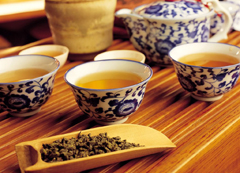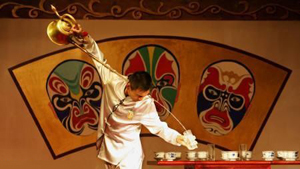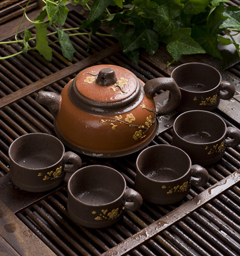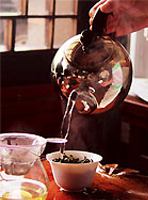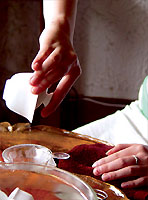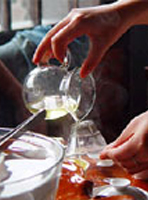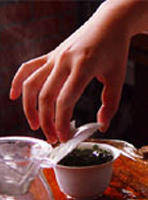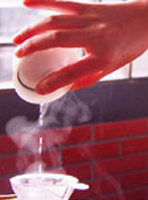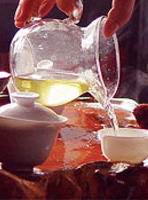
Chinese tea is a beverage from the leaves of tea plants (Camellia sinensis), which are ordinarily used for tea in China. Tea leaves are processed using traditional Chinese methods. The Chinese drink tea throughout the day, including during meals, as a substitute for plain water for health or simple pleasure.
| | China is the homeland of tea. It is believed that China has tea-shrubs as early as five to six thousand years ago, and human cultivation of tea plants dates back two thousand years. Tea from China, along with her silk and porcelain, began to be known the world over more than a thousand years ago and has since always been an important Chinese export. At present more than forty countries in the world grow tea with Asian countries producing 90% of the world's total output. All tea trees in other countries have their origin directly or indirectly in China. Our history of tea begins in China. Tea is given its 'birth date' of 2737 BC. |
--------------------------------------------------------------------------------------------------------------------------------------------------------------------
| The Chinese have a saying: 'Firewood, rice, oil, salt, sauce, vinegar and tea are the seven necessities to begin a day.' Though tea is last on the list, we still can see its importance in daily life. | |
| | A simple meal in Chinese is Cu Cha Dan Fan, namely coarse tea and tasteless dinner. Even a simple meal is finished off with tea so its importance is obvious. For the Chinese, tea drinking and tasting are not the same. Tea drinking is for refreshment and tonic effect. Tea tasting has cultural meaning. Tea and tea wares should match surrounding elements such as breeze, bright moon, pines, bamboo, plums and snow. |
| All these show the ultimate goal of Chinese culture: the harmonious unity of human beings with nature. Tea is compared to personal character. Tea is regarded as the most Zen-like drink. | |
--------------------------------------------------------------------------------------------------------------------------------------------------------------------
Although there are hundreds of varieties of Chinese tea, they can mainly be classified into five categories. There is no agreement on the classification of tea. It can be classified by procedure, quality, preparation methods, and so on. The main classifications are determined by the method of processing the tea. The six types are Black Tea, Green Tea, Herbal Tea, Pu-erh Tea, Oolong Tea, White Tea and Yellow Tea.
Main Types of Chinese Tea
| Black Tea |
| Green Tea | ||
| | There are four famous black tea in the world: Keemun of China, Darjeeling of India, Uva of Sri Lanka and Assam of India. Our Chinese black tea is guaranteed from authentic producing areas with top quality. |
| | Green tea is the top of famous six kinds of teas. The features are clear soup and green leaves. Green tea can induce thermogenesis and stimulate fat burning, boost the metabolic and healthy for you. |
| Herbal Tea |
| Oolong Tea | ||
| | Herbal tea is a kind of tea only in China, which is made from anything other than the leaves of the tea bush, contains both the faint scent of tea leaves and fragrant of flowers. These ones don't like the bitter taste of tea. |
| | Oolong tea is also called as Wu Long Tea or WuLong Tea.It has both strong delicate flavour of black tea and faint scent of green tea, strong sweet flavour possess unique lingering charm. It is quite effective in losing weight. |
| White and Yellow Tea |
| Pu-erh Tea | ||
| | As the mild fermentation tea,white tea is the specialty, which is made of pekoe without fixation or rolling. The color is white as silver. Yellow tea is the treasure of teas, belongs to fermentation tea.(Jun Shan Yin Zhen and Meng Ding Huang Ya.) |
| | Pu-erh tea is loose tea and brick tea after fermented utilized large leaves sunning crudely tea planted in Yun Nan province in China. The color is auburnish red, infusion is bright red, stale flavour is unique, taste is thick and sweet |
--------------------------------------------------------------------------------------------------------------------------------------------------------------------
| | Tea wares consist of ovens, tea rollers, teapots, cups, bowls, and trays and so on. Nowadays with the development of its procedure, we can make a cup of tea with a single porcelain cup. In the following passage, we will focus on the most essential teapot and scups. Though not as strict as the tea ceremony in Japan, certain rules govern the Chinese understanding of tea. Take tea wares as an example. Green tea goes with white porcelain or celadon without a cover; scented one with celadon or blue and white porcelain with a cover; black one goes well with purple clay ware with white inside glaze, or with white porcelain or warm colored or coffee wares; and Oolong tea is also excellent in purple clay ware. In a word, the harmonious combination of function, material, and color of tea ware is essential to excellent tea. |
--------------------------------------------------------------------------------------------------------------------------------------------------------------------
Health Benefits
| Tea has more healthful properties than any other plant. Tea has been used for centuries and been found in scientific studies to be protective against cancers, viruses, bacteria, plague, diabetes, tooth decay and aging. Tea is loaded with protective organic compounds that coat and seal exposed cell surfaces and bind loose ends of DNA. A small amount of these tea compounds in and on the body protects and repairs many types of general environmental damage and stresses. Researchers are finding that all teas -- white, green, oolong and black tea from the Camellia sinensis plant -- may aid in achieving a long and healthy life. Tea contains flavonoids, compounds with antioxidant properties. Antioxidants work to neutralize free radicals that may damage the body and contribute to chronic diseases. White and green teas contain the most antioxidant properties, followed by Oolong and then Black teas. | |
--------------------------------------------------------------------------------------------------------------------------------------------------------------------
| | | |
| 1.Infuse with 85-90 degrees boiling water | 2.Clean the tea leaves fully | 3.Pour the infusion out |
| | | |
| 4.Make the second infusion | 5.Steep the tea for about 1-2 minutes | 6.Transfer the tea into the vessel |
| |
|
|
| 7.Enjoy yourself with the teacup |
|
|
Written by Nicolas Yang
